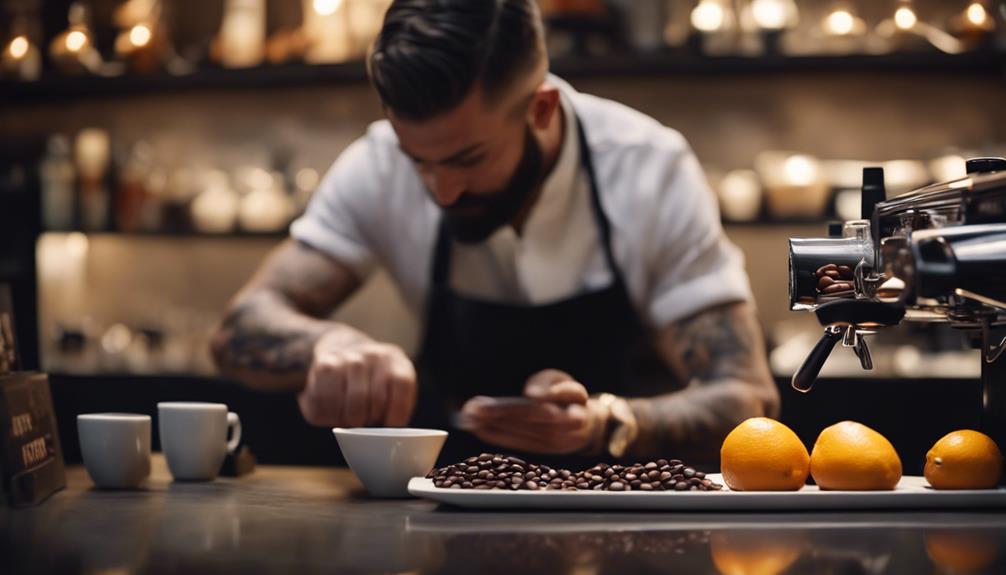Using medium roast coffee for espresso enhances the beans’ natural richness, providing a balanced and smooth flavor profile. This roast level offers a versatile and less acidic taste for a satisfying coffee experience. Medium roast achieves a harmonious balance, natural coffee flavors, moderate acidity, and richness without bitterness. It pairs well with milk-based drinks and offers a velvety finish. The beans are roasted at 410°F-430°F, preserving their natural flavors without visible oil. Italian baristas recommend this roast for its notes of chocolate, caramel, and spices, making it a delightful choice.
Key Takeaways
- Balanced flavor profile ideal for espresso enjoyment.
- Lower acidity for a smoother espresso experience.
- Natural flavors shine through in medium roast beans.
- Versatile for various espresso drinks.
- Moderate caffeine content for a well-rounded espresso.
Benefits of Medium Roast for Espresso
Moreover, medium roast coffee offers a balanced flavor profile that complements the rich taste of your espresso. When used in espresso preparations, medium roast beans provide a versatile option, allowing for different drink types and ratios to be explored.
The less acidic nature of medium roasts makes them ideal for crafting intense espresso shots that don't overwhelm with sharpness. Moreover, the natural flavors inherent in medium roast coffee beans enhance the overall taste experience of your espresso, adding depth and complexity to each sip.
In addition, medium roast beans boast a moderate caffeine content, perfect for those seeking a milder espresso experience without sacrificing the rich taste that espresso is known for. Whether you enjoy your espresso straight or as the base for specialty drinks, medium roast coffee can elevate your coffee game by offering a well-rounded flavor profile that complements the boldness of espresso.
Flavor Profile of Medium Roast Espresso

When exploring the flavor profile of medium roast espresso, you'll discover a harmonious balance that showcases natural coffee bean flavors while maintaining a moderate level of acidity.
Medium roast espresso is known for its balanced taste, offering a smoother and less acidic experience compared to light roasts. The moderate roasting process brings out the natural flavors of the beans without overshadowing them, allowing for a versatile and widely enjoyed espresso.
Unlike dark roasts, medium roast espresso beans typically don't have visible oil on their surface, indicating a moderate level of roasting that preserves the beans' intrinsic characteristics. This type of espresso strikes a harmonious balance between the richness of dark roasts and the bright acidity of light roasts, making it a popular choice for those seeking a well-rounded and flavorful coffee experience.
Whether you enjoy it black or with milk, medium roast espresso provides a satisfying and versatile option for coffee enthusiasts.
Sourcing Medium Roast Coffee Beans

When sourcing medium roast coffee beans for your espresso, consider the bean flavor profile, the impact of the roasting process, and brewing recommendations.
Medium roast beans offer a balanced flavor ideal for espresso, with lower acidity and a clean appearance for brewing. Baristas often recommend this type of roast for its rich flavor and versatile use in various espresso drinks.
Bean Flavor Profile
To enhance your espresso experience, consider sourcing medium roast coffee beans known for their balanced flavor profile.
When selecting medium roast coffee beans for your espresso, you can expect:
- Moderate Acidity and Sweetness: Medium roast beans offer a pleasant acidity level and natural sweetness, enhancing the overall flavor of your espresso.
- Versatile Taste: These beans provide a versatile taste that pairs well with different espresso drink types, catering to a wide range of preferences.
- Chocolatey, Nutty, and Caramel Undertones: Enjoy the delightful flavor notes of chocolate, nutty hints, and subtle caramel undertones that add depth to your espresso.
- Rich Taste without Bitterness: Medium roast coffee beans offer a rich taste profile without overpowering bitterness, ensuring a balanced and enjoyable espresso experience.
- Harmonious with Milk-Based Drinks: The natural flavor profile of medium roast beans complements milk-based espresso beverages, creating a harmonious and satisfying blend of flavors.
Roasting Process Impact
The roasting process greatly impacts the flavor profile of medium roast coffee beans, essential for sourcing quality beans for your espresso.
Medium roast coffee beans are heated to temperatures between 410°F and 430°F until the second crack, resulting in a balanced flavor that's perfect for espresso. This process retains the beans' natural flavors while reducing acidity when compared to light roasts, enriching the overall espresso experience.
Additionally, medium roast coffee beans contain slightly less caffeine than lighter roasts, making them a versatile choice for various espresso-based beverages. These beans don't display visible oil on their surface, ensuring a clean appearance in the espresso puck.
Italian baristas particularly recommend medium roast coffee for espresso due to its versatility and its ability to blend harmoniously with milk, creating classic espresso drinks that are rich and flavorful.
When selecting medium roast coffee beans for your espresso, consider the impact of the roasting process on the final flavor profile.
Brewing Recommendations
For sourcing medium roast coffee beans for your espresso, consider exploring local roasters or specialty coffee shops in your area. When searching for the perfect medium roast beans, keep in mind these key factors:
- Medium roast coffee beans are ideal for espresso due to their balanced flavor and versatility in brewing methods.
- Sourcing medium roast coffee beans guarantees a rich taste with moderate acidity, perfect for traditional espresso shots.
- Medium roast beans offer a natural flavor with slightly lower caffeine content, making them suitable for various espresso-based drinks.
- Opting for medium roast coffee beans provides for a smooth and velvety finish in milk-based espresso beverages.
- Medium roast coffee beans are roasted to perfection between 410°F-430°F, providing a satisfying espresso experience with just the right amount of acidity and complexity.
Exploring local options can lead you to discover high-quality medium roast coffee beans that will elevate your espresso brewing experience.
Brewing Tips for Medium Roast Espresso

When brewing medium roast espresso, consider the grind size, extraction time, and temperature. A fine grind is essential for the best extraction, ensuring a balanced flavor.
Experiment with extraction time and temperature to fine-tune the taste of your medium roast espresso.
Grind Size for Espresso
To achieve a balanced and flavorful medium roast espresso shot, make sure your grind size is fine, similar to table salt.
- Adjusting the grind size is essential to control the flow rate and extraction time, ensuring a well-balanced shot.
- Ideal pressure during brewing is achieved with a fine grind, resulting in a flavorful medium roast espresso.
- Using a quality burr grinder with precise settings is recommended for the perfect grind size.
- Inconsistent grind sizes can lead to under-extraction or over-extraction, impacting taste and quality.
- Fine grind size allows for proper extraction, contributing to a delicious and well-rounded medium roast espresso shot.
Extraction Time and Temperature
Maintaining the ideal extraction time and temperature is key to achieving a flavorful medium roast espresso shot. When brewing medium roast coffee for espresso, the extraction time and temperature play vital roles in bringing out the balanced flavor profile that combines acidity and richness harmoniously.
Medium roast espresso offers a forgiving window for ideal brewing, allowing the espresso machine to effectively extract the coffee's essence while preserving its natural flavors. The slightly lower acidity of medium roast compared to light roasts makes it a preferred choice for those looking for a smoother espresso experience.
This smooth espresso serves as a versatile base for various espresso-based drinks, letting the coffee's nuances shine through and complementing different milk textures. By carefully controlling the extraction time and temperature, you can maximize the full potential of medium roast coffee, creating a rich and satisfying espresso experience every time.
Medium Roast Vs. Other Roast Levels

Medium roast coffee stands out from other roast levels due to its balanced flavor profile and versatility for espresso preparation.
Here are some key differences between medium roast and other roast levels:
- Balanced Flavor Profile: Medium roast beans offer a well-rounded flavor that strikes a middle ground between the brighter notes of light roasts and the smokier tones of dark roasts.
- Lower Acidity Level: Compared to light roasts, medium roasts have a slightly reduced acidity level, making them ideal for creating a smooth and mellow espresso.
- No Visible Oil: Medium roast espresso beans don't display visible oil on their surface, unlike dark roasts, which can lead to a cleaner brewing process.
- Moderate Caffeine Content: Medium roast coffee contains a moderate amount of caffeine, making it a suitable choice for those seeking a balanced energy boost.
- Rich Taste: Italian baristas often recommend medium roast coffee for espresso due to its rich taste that avoids the bitterness associated with dark roasts.
Medium Roast Espresso Pairings

Consider pairing your medium roast espresso with milk-based drinks like lattes and cappuccinos to enhance the flavor experience. The balanced acidity and rich, velvety finish of medium roast coffee brewing methods create a harmonious combination when mixed with milk, resulting in a smooth and satisfying taste. This type of espresso is known for its ability to maintain its flavor profile even when combined with milk, making it an ideal choice for those who enjoy creamy beverages. The medium roast espresso's versatility allows it to adapt well to different brewing ratios, ensuring a consistent and enjoyable cup every time. Below is a table summarizing the key points of pairing medium roast espresso with milk-based drinks:
| Aspect | Description |
|---|---|
| Flavor Profile | Balanced acidity with a rich, velvety finish |
| Ideal Pairing | Milk-based drinks like lattes and cappuccinos |
| Textural Quality | Provides a smooth and well-rounded taste for a satisfying coffee experience |
Exploring Medium Roast Espresso Varieties

Explore the diverse range of medium roast espresso varieties available to discover unique flavor profiles and aromas that can elevate your coffee experience. When delving into medium roast espresso, you'll find a selection of beans that offer a balanced flavor profile with slightly lower acidity, making for a pleasant and smooth cup of coffee.
Roasted to perfection at temperatures ranging from 410°F to 430°F, these beans serve as an ideal foundation for your espresso brewing endeavors. Medium roast espresso beans boast a natural flavor that shines through without visible oil on the surface, ensuring a pure coffee essence in every sip.
Unlock the world of medium roast espresso with recommendations from Italian baristas who value these beans for their versatility in espresso preparation. Indulge in the delightful notes of chocolate, caramel, and spices that medium roast espresso varieties can bring to your cup, enhancing your coffee experience with every sip. Enjoy the richness and complexity that these beans offer in each carefully crafted espresso shot.
- Balanced flavor profile with lower acidity
- Roasted at 410°F-430°F
- Natural flavor without visible oil
- Recommended by Italian baristas
- Notes of chocolate, caramel, and spices
Frequently Asked Questions
Is Medium Roast Good for Espresso?
Medium roast is excellent for espresso. It offers a balanced flavor profile, slightly lower acidity, and showcases various flavor notes.
Roasted to 410°F-430°F, it's versatile for brewing methods. With a rich color and no visible oil, it maintains a clean appearance. Italian baristas recommend it for balancing sweetness, acidity, and body in your shot.
What Type of Coffee Is Best for Espresso?
For espresso, the best type of coffee is medium roast due to its balanced flavor profile and adaptability. It provides a rich taste with chocolatey or caramel notes, favored by Italian baristas.
Medium roast beans are roasted to 410°F-430°F, offering a less acidic flavor than light roasts. They produce a well-extracted shot without visible oil on the surface, resulting in a pleasing mouthfeel.
Start with medium roast for a delicious espresso experience.
Can I Use Any Dark Roast Coffee for Espresso?
Yes, you can use any dark roast coffee for espresso, but it may not be the most ideal choice. Dark roasts tend to have intense flavors that can result in bitterness and overpower the nuanced notes of espresso.
Adjustments to grind size and brewing parameters might be needed to achieve a balanced shot.
Experimenting with different roast levels can help find the right balance of flavor and intensity for your espresso taste preferences.
Why Not Use Light Roast for Espresso?
Using light roast for espresso may not give you the bold, rich flavors you crave. Its high acidity and earthy taste mightn't hit the mark for your espresso experience.
Light roasts lack the body and oil that medium roasts bring to the table. Heating them for a shorter time means they may not reach the ideal temperatures for the perfect espresso extraction.
In the end, medium roast coffee shines for that classic, velvety espresso finish you love.
Can Espresso Roast Be Used for Medium Roast Coffee in Espresso Making?
Yes, espresso roast can be used for medium roast coffee in espresso making. The darkness in espresso roast can provide a rich and bold flavor that is perfect for making espresso. It can add depth and complexity to your espresso without the bitterness often associated with darker roasts.
Conclusion
So, next time you're brewing up a shot of espresso, remember to reach for that medium roast coffee.
With its balanced flavor and versatility, medium roast espresso is sure to satisfy your caffeine cravings.
Don't miss out on the rich, smooth taste that medium roast brings to your daily coffee routine.
Make the switch today and elevate your espresso experience to a whole new level.
Cheers to a perfect cup of joe!








